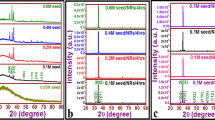Abstract
We report the synthesis and optical properties of compact and aligned ZnO nanorod arrays (dia, ∼ 50–200 nm) grown on a glass substrate with varying seed particle density. The suspension of ZnO nanoparticles (size, ∼ 15 nm) of various concentrations are used as seed layer for the growth of nanorod arrays via selfassembly of ZnO from solution. We studied the effect of various growth parameters (such as seeding density, microstructure of the seed layer) as well as the growth time on the growth and alignment of the nanorods. We find that the growth, areal density and alignment of the nanorods depend on the density of seed particles which can be controlled. It is observed that there is a critical density of the seed particles at which nanorod arrays show maximum preferred orientation along [002] direction. The minimum and maximum radius of the aligned nanorods synthesized by this method lie in the range 50–220 nm which depend on the seeding density and time of growth. These nanorods have a bandgap of 3.3 eV as in the case of bulk crystals and show emission in the UV region of the spectrum (∼ 400 nm) due to excitonic recombination and defect related emission in the visible region.
Similar content being viewed by others
References
Banerjee D, Jo S H and Ren Z F 2004 Adv. Mater. 16 2028
Cao M H, Guo C X, Qi Y J, Hu C W and Wang E B 2004 J. Nanosci. Nanotechnol. 4 829
Chander R and Raychaudhuri A K 2006 J. Mater. Sci. 41 3623
Chen D R, Jiao X L and Cheng G 1999 Solid State Commun. 113 363
Ding G Q, Zheng M J, Xu W L and Shen W Z 2005 Nanotechnology 16 1285
Djurisic A B et al 2007 Nanotechnology 18 095702
Dorfman A, Kumar N and Hahm J 2006 Adv. Mater. 18 2685
Garcia S P and Semancik S 2007 Chem. Mater. 19 4016
Ghosh M and Raychaudhuri A K 2006 J. Appl. Phys. 100 034315
Ghosh M and Raychaudhuri A K 2007 Nanotechnology 18 115618
Guo M, Diao P and Cai S 2005 J. Solid State Chem. 178 1864
Greene L E, Law M, Goldberger J, Kim F, Johnson J C, Zhang Y, Saykally R J and Yang P 2003 Angew. Chem. Int. Ed. 42 3031
Heo Y W, Norton D P and Pearton S J 2005 J. Appl. Phys. 98 073502
Hirate T, Sasaki S, Li W C, Miyashita H, Kimpara T and Satoh T 2005 Thin Solid Films 487 35
Jang E S, Won J H, Hwang S J and Choy J H 2006 Adv. Mater. 18 3309
Kim J H, Andeen D and Lange F F 2006 Adv. Mater. 18 2453
Kim T Y, Kim J Y, Lee S H, Shim H W, Lee S H, Suh E K and Nahm K S 2004 Synth. Met. 144 61
Kind H, Yan H Q, Messer B, Law M and Yang P D 2002 Adv. Mater. 14 158
Kumar S, Gupta V and Sreenivas K 2005 Nanotechnology 16 1167
Lee C J, Lee T J, Lyu S C, Zhang Y, Ruh H and Lee H J 2002 Appl. Phys. Lett. 81 3648
Li S Y, Lin P, Lee C Y, Ho M S and Tseng T Y 2004 J. Nanosci. Nanotechnol. 4 968
Lu C H and Yeh C H 2000 Ceram. Int. 26 351
Ma T, Guo M, Zhang M, Zhang Y and Wang X 2007 Nanotechnology 18 035605
Minami T 2005 Semicond. Sci. Technol. 20 S35
Pacholski C, Kornowski A and Weller H 2002 Angew. Chem. Int. Ed. 41 1188
Park J, Choi H H, Siebein K and Singh R K 2003 J. Cryst. Growth 258 342
Ramgir N S, Mulla I S, Vijayamohanan K, Late D J, Bhise A B, More M A and Joag D S 2006 Appl. Phys. Lett. 88 042107
Shalish I, Temkin H and Narayanamurti V 2004 Phys. Rev. B69 245401
Sun X W, Yu S F, Xu C X, Yuen C, Chen B J and Li S 2003 Jpn. J. Appl. Phys. 42 L1229
Travnikov V V, Freiberg A and Savikhin S F 1990 J. Lumines. 47 107
Vayssieres L, Keis K, Hagfeldt A and Lindquist S-E 2001 Chem. Mater. 13 4395
Wang J F, Gudiksen M S, Duan X F, Cui Y and Lieber C M 2001 Science 293 1455
Wang Xudong, Zhou J, Lao C, Song J, Xu N and Wang Z L 2007 Adv. Mater. 19 1627
Zhang Y S, Wang L S, Liu X H, Yan Y J, Chen C Q and Zhu J 2005 J. Phys. Chem. B109 13091
Author information
Authors and Affiliations
Corresponding author
Rights and permissions
About this article
Cite this article
Ghosh, M., Bhattacharyya, R. & Raychaudhuri, A.K. Growth of compact arrays of optical quality single crystalline ZnO nanorods by low temperature method. Bull Mater Sci 31, 283–289 (2008). https://doi.org/10.1007/s12034-008-0046-9
Published:
Issue Date:
DOI: https://doi.org/10.1007/s12034-008-0046-9



